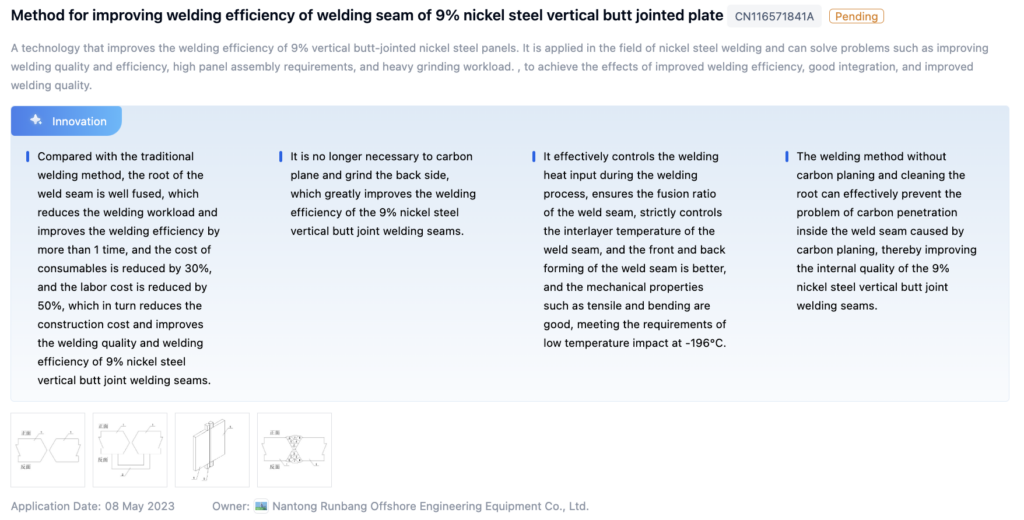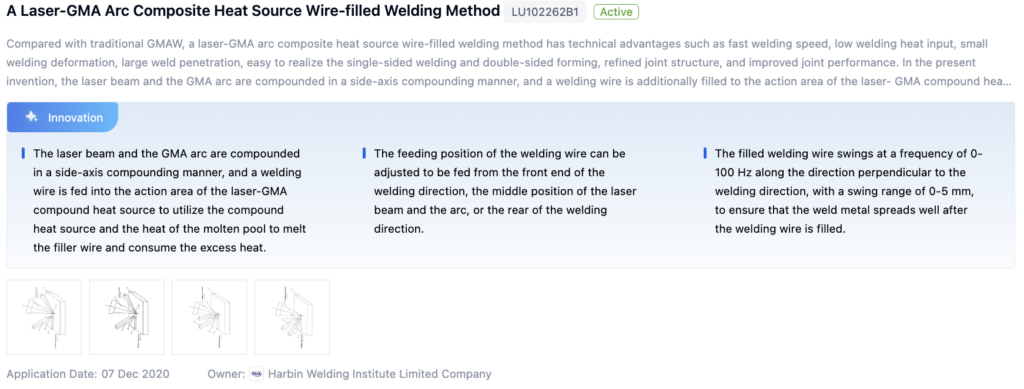
Technical Background and Objectives
Background
In the field of fusion welding, improving welding efficiency has been a key focus of research and development. The data shows a steady increase in patent filings over the years, indicating ongoing innovation and investment. However, literature publications have fluctuated, suggesting varying levels of academic research interest over time. This divergence between patents and literature may indicate sustained industrial efforts to develop new technologies despite periods of fluctuating academic focus.

Objectives
The primary objective is to enhance the efficiency of fusion welding processes, thereby reducing production costs and increasing productivity. This research aims to develop innovative solutions that streamline the fusion welding process, resulting in significant cost savings and improved competitiveness for manufacturers.
To get a detailed scientific explanations of Fusion Welding, try Eureka.
Technical Current Status Analysis
Fusion Welding Overview
Fusion welding, also known as arc welding, is a widely used joining process in industries such as construction, automotive, shipbuilding, and energy. It involves melting and fusing metal components using an electric arc. Despite its advantages, improving welding efficiency remains critical for enhancing productivity and reducing operational costs.
Applications and Impact:
- Construction: Fabrication of steel structures, pipelines, and infrastructure.
- Automotive: Assembly of vehicle bodies, chassis, and components.
- Shipbuilding: Construction of ships, offshore platforms, and maritime structures.
- Energy: Fabrication and maintenance of power plants, oil and gas facilities, and renewable energy installations.
Technical Characteristics and Challenges:
- Heat Input and Arc Stability: Controlling heat input and maintaining a stable arc to ensure consistent weld quality.
- Joint Preparation and Fit-Up: Proper preparation to achieve high-quality welds and minimize distortion.
- Filler Metal Selection and Control: Choosing appropriate filler metal and controlling its deposition rate.
- Welding Position and Accessibility: Addressing challenges in difficult positions and limited accessibility.
- Automation and Robotics: Integrating automation to improve consistency and reduce human error.
- Skilled Workforce: Ensuring a skilled workforce through training and certification.
- Process Monitoring and Quality Control: Effective monitoring and control to identify and address issues impacting efficiency.
Technological Paths:
- Advanced Welding Processes: Implementing pulsed arc welding, double-wire welding, or hybrid techniques.
- Adaptive Control Systems: Developing systems to automatically adjust welding parameters.
- Intelligent Sensing and Monitoring: Using machine vision, thermal imaging, and acoustic emission monitoring.
- Simulation and Modeling: Utilizing computational tools for parameter optimization and process planning.
- Automation and Robotics: Integrating robotic systems for high-volume or repetitive applications.
- Workforce Training and Certification: Investing in training programs to enhance skills and adherence to best practices.
- Lean Manufacturing Principles: Adopting principles to identify and eliminate inefficiencies.

Research Content
Research Objectives
Enhance the efficiency of fusion welding processes, reducing production costs and increasing productivity.
Research Direction and Focus
Optimizing Welding Parameters
- Investigate the impact of heat input, travel speed, and shielding gas composition on weld quality and efficiency.
- Use computational modeling and simulation to identify optimal parameter settings.
Developing Advanced Welding Techniques
- Explore hybrid welding methods and additive manufacturing techniques for enhanced efficiency.
- Investigate automation and robotics integration for consistent and repeatable operations.
Implementing Intelligent Monitoring and Control Systems
- Develop systems leveraging advanced sensors, data analytics, and machine learning for real-time parameter adjustment.
- Minimize rework and material waste through early detection and mitigation of defects.
Technical Development Roadmap
Key Areas of Advancement
- Advanced Welding Processes: Fiber laser welding, friction stir welding, and plasma-MIG hybrid welding.
- Welding Automation and Robotics: Adaptive robotic welding systems, machine learning for real-time monitoring, and collaborative welding robots.
- Welding Simulation and Modeling: Computational weld mechanics modeling, augmented reality for training, and digital twins for process optimization.

Main Player Analysis
Key Players and Focus
- Kobe Steel Ltd.: Focus on optimizing process parameters, developing advanced materials, and exploring novel techniques.
- Harbin Institute of Technology: Research on weaving gas tungsten arc welding, hybrid laser-MAG welding, and microstructural analysis.
- NIPPON STEEL CORP.: Innovations in high-strength steel welding, dissimilar material joining, and specialized techniques for harsh environments.
- Daiichi Shokai Co. Ltd.: Advancements in high-strength steel welding, aluminum alloy welding, and dissimilar material joining.
- Shanghai Jiao Tong University: Research on post-weld heat treatment, wire arc additive manufacturing, and narrow-gap laser welding.
Current Technical Solution Overview
Optimizing Fusion Welding Process Parameters
- Optimizing Parameters: Techniques to adjust current, voltage, and travel speed for optimal weld quality and efficiency.
- Monitoring and Control Systems: Real-time monitoring and adjustment of the welding process using sensors and feedback loops.
- Weld Pool Control and Shaping: Techniques to control and shape the weld pool during fusion welding.
- Fusion Welding of Dissimilar Materials: Specialized techniques and parameters for welding dissimilar materials.
- Weld Joint Design and Preparation: Proper joint design and preparation to improve weld quality and efficiency.
Improving Weld Penetration and Fusion Zone
- Monitoring and Controlling Penetration Depth: Methods to monitor and control weld penetration depth in real-time.
- Weld Joint Design for Improved Penetration: Designs and configurations to enhance weld penetration.
- Welding Process Modifications: Techniques like hybrid welding and laser welding for increased penetration.
- Weld Penetration Measurement and Inspection: Techniques for measuring and inspecting weld penetration.
- Weld Penetration Control Systems: Advanced control systems to maintain desired weld penetration.
Monitoring and Control Systems for Fusion Welding
- Monitoring Systems: Systems for real-time monitoring of the welding process using sensors.
- Weld Quality Monitoring and Defect Detection: Techniques for evaluating weld quality and detecting defects.
- Adaptive Control and Optimization: Systems to adaptively control and optimize welding parameters based on real-time data.
- Weld Data Management: Systems for managing and tracking weld data for quality control and process optimization.
Specialized Welding Techniques and Materials
- Welding Process Control: Techniques for controlling the welding process to improve quality and efficiency.
- Hybrid and Combined Welding Processes: Combining different welding processes for improved efficiency.
- Weld Pool Monitoring and Control: Techniques for monitoring and controlling weld pool attributes.
- Specialized Techniques for Specific Applications: Techniques tailored for specific applications or materials.
- Weld Parameter Optimization: Techniques for automatically determining and optimizing welding parameters.
Weld Joint Design and Preparation
- Weld Joint Design for Improved Fatigue Performance: Designs to enhance the fatigue performance of welded structures.
- Weld Joint Design for Dissimilar Materials: Designs to ensure the integrity of joints between dissimilar materials.
- Weld Joint Design for Additive Manufacturing: Designs to ensure the structural integrity of additively manufactured parts.
- Weld Joint Design for Friction Stir Welding: Designs to optimize material flow and joint quality.
- Weld Joint Design for Improved Productivity: Designs to increase efficiency and productivity of the welding process.
Key Patent Interpretation
Patent Highlights
Patent 1: Method for Improving Welding Efficiency of 9% Nickel Steel Transverse Butt Jointed Board
- Core Invention Points:
- Root of the weld seam is well fused, reducing welding workload and improving efficiency.
- No carbon planing and grinding required on the back side, enhancing efficiency.
- Controls welding heat input, ensuring good fusion and mechanical properties.

Patent 2: Method for Improving Welding Efficiency of 9% Nickel Steel Vertical Butt Jointed Plate
- Core Invention Points:
- Root of the weld seam is well fused, reducing workload and improving efficiency.
- No carbon planing and grinding required on the back side, enhancing efficiency.
- Controls welding heat input, ensuring good fusion and mechanical properties.

Patent 3: Laser-GMA Arc Composite Heat Source Wire-Filled Welding Method
- Core Invention Points:
- Combines laser beam and GMA arc, with a welding wire for improved efficiency.
- Adjusts wire feeding position for optimal heat utilization.
- Ensures well-spread weld metal and improved joint performance.

Possible Research Directions
- Controlling Fusion Depth and Weld Penetration: Methods to ensure optimal weld quality and reduce defects.
- Optimizing Fusion Welding Processes: Approaches to enhance efficiency by improving weld quality and productivity.
- Improving Weld Joint Properties: Methods to enhance mechanical properties and performance of welded joints.
- Specialized Fusion Welding Techniques: Techniques like laser welding and electron beam welding for challenging applications.
If you want an in-depth research or a technical report, you can always get what you want in Eureka Technical Research. Try now!

